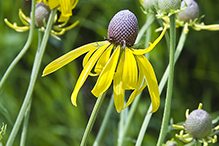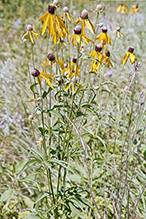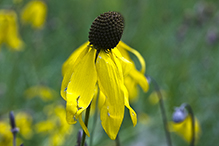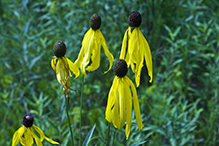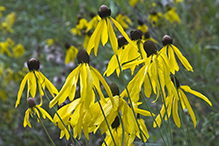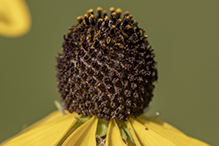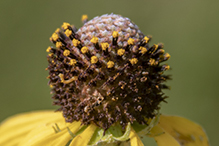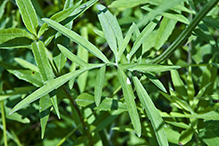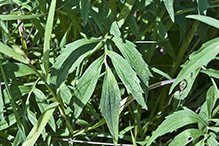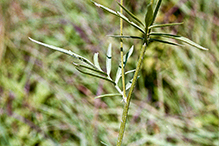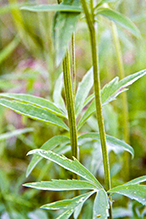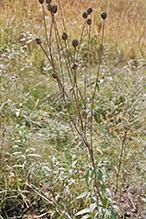gray-headed coneflower
(Ratibida pinnata)
Conservation • Description • Habitat • Ecology • Use • Distribution • Taxonomy
Conservation Status |
|
|||||||
| IUCN Red List | not listed |
|||||||
| NatureServe | N5? - Secure SNR - Unranked |
|||||||
| Minnesota | not listed |
|||||||
Description |
||
Gray-headed coneflower is an erect, 16″ to 48″ tall, perennial forb that rises on a single stem or 2 to 12 or more stems from fibrous roots and either a woody, underground, storage organ (caudex), or often a short, stout, horizontal, underground stem (rhizome). It sometimes appears clustered. A single stem or 2 to 12 or more stems rises from a rosette of basal leaves. The stem is erect, rough to the touch, and branched only above the middle. It has several longitudinal ridges. It is moderately to densely covered with coarse, short, straight, stiff, ascending, usually appressed hairs. It is sometimes hairless near the base. It also has scattered, minute, stalkless, yellow glands. Basal and lower stem leaves are lance-shaped to egg-shaped, inversely lance-shaped to inversely egg-shaped, or oblong in outline, up to 16″ long, and up to 6″ wide. They are on long leaf stalks. Each leaf is either deeply lobed (pinnatifid) with 3 to 9 narrow lobes cut nearly to the midvein or pinnately divided into 3 to 9 narrow leaflets. The leaflets on pinnate leaves are often toothed and shallowly or deeply lobed. The ultimate lobes and undivided leaflets are narrowly lance-shaped to egg-shaped, up to 6″ long, and up to 1⅜″ wide. They have 1 or 3 main, parallel veins. The upper and lower surfaces are rough to the touch. They are moderately to densely covered with short, straight, stiff, sharp, appressed to more or less spreading hairs. They are also dotted with scattered, minute, stalkless or impressed, yellow glands. The margins are usually untoothed. The leaves become smaller, shorter stalked, and less divided as they ascend the stem. Upper stem leaves are stalkless and often undivided and lance-shaped. The inflorescence is a single, showy flower head at the end of each stem and branch. Most plants have 1 to 12 flower heads. The flower heads are held well above the leaves. Each flower head is at the end if a leafless, prominently ribbed, 1¼″ to 10½″ long stalk (peduncle). The whorl of bracts at the base of the flower head (involucre) is narrowly saucer-shaped, more or less round with a shallow depth. It is composed of 10 to 15 bracts (phyllaries) in 2 overlapping series. The outer phyllaries are linear, ⅛″ to ⅝″ long, and 1 ⁄32″ to ⅛″ wide. The inner phyllaries are narrowly egg-shaped, ⅛″ to ¼″ long, and 1 ⁄64″ to ⅛″ wide. The flower head has 6 to 15 ray florets and 100 to 200 or more disk florets. The ray florets are yellow, linear ellipse-shaped to oblong inversely egg-shaped, 1 3 ⁄16″ to 2⅜″ long, and 3 ⁄16″ to ⅝″ wide. They droop downward at the base of the receptacle. The receptacle is usually oblong or egg-shaped, sometimes nearly globe-shaped, ⅜″ to 1″ long, and ⅜″ to ¾″ wide. It is covered with disk florets. The disk florets are 1 ⁄16″ to ⅛″ wide and greenish-yellow, sometimes purple tinged toward the tip. The fruit is a dry, one-seeded, 1 ⁄16″ to ⅛″ long seed capsule (cypsela). The tip of the cypsela is flattened and has no hairs but often 1 or 2 tooth-like projections. |
||
Height |
||
16″ to 48″ |
||
Flower Color |
||
Yellow ray florets, light green or gray head, dark brown disk florets |
||
Similar Species |
||
Long-headed coneflower (Ratibida columnifera) is usually much shorter, no more than 24″ in height. The ray florets are shorter, no more than 1⅜″ long. The disk is column-shaped and much longer, up to 2″ long. |
||
Habitat |
||
Dry to wet. Prairies, woodland openings. Full sun. |
||
Ecology |
||
Flowering |
||
June to August |
||
Pests and Diseases |
||
|
||
Use |
||
|
||
Distribution |
||||
|
Sources |
|||
| 4/26/2023 | ||||
Nativity |
||||
Native |
||||
Occurrence |
||||
Common |
||||
Taxonomy |
|||
| Kingdom | Plantae (Plants) | ||
| Division | Tracheophyta (Vascular Plants) | ||
| Subdivision | Spermatophytina (Seed Plants) | ||
| Class | Magnoliopsida (Dicots) | ||
Order |
Asterales (Sunflowers, Bellflowers, Fanflowers, and Allies) | ||
Family |
Asteraceae (Sunflowers, Daisies, Asters, and Allies) | ||
| Subfamily | Asteroideae | ||
| Supertribe | Helianthodae | ||
| Tribe | Heliantheae (Sunflowers and Allies) | ||
| Subtribe | Rudbeckiinae (black-eyed Susans, coneflowers, and prairie coneflowers) | ||
| Genus | Ratibida (coneflowers) | ||
Subordinate Taxa |
|||
|
|||
Synonyms |
|||
Lepachys pinnata Rudbeckia pinnata |
|||
Common Names |
|||
drooping prairie-coneflower globular coneflower grayhead prairieconeflower gray-head prairie-coneflower gray-headed coneflower pinnate prairie coneflower pinnate-leaf prairie-coneflower prairie coneflower yellow coneflower |
|||
Glossary
Bract
Modified leaf at the base of a flower stalk, flower cluster, or inflorescence.
Caudex
A short, thickened, woody, persistent enlargement of the stem, at or below ground level, used for water storage.
Cypsela
A dry, one-chambered, single-seeded fruit, formed from a single carpel, with the seed attached to the membranous outer layer (wall) only by the seed stalk; the wall, formed from the wall of the inferior ovary and also from other tissues derived from the receptacle or hypanthium, does not split open at maturity, but relies on decay or predation to release the contents.
Involucre
A whorl of bracts beneath or surrounding a flower, flower head, or flower cluster.
Linear
Long, straight, and narrow, with more or less parallel sides, like a blade of grass.
Phyllary
An individual bract within the involucre of a plant in the Asteraceae family.
Pinnate
On a compound leaf, having the leaflets arranged on opposite sides of a common stalk. On a bryophyte, having branches evenly arranged on opposite sides of a stem.
Pinnatifid
Deeply cut, more than half way to the midrib but not to the midrib, into lobes that are spaced out along the midrib; the lobes do not form separate leaflets.
Receptacle
The thickened, upper part of a flower stalk to which flowers or flower parts are attached. In composite flowers, the part on which the flowers are borne. In accessory fruits the receptacle gives rise to the edible part of the fruit.
Rhizome
A horizontal, usually underground stem. It serves as a reproductive structure, producing roots below and shoots above at the nodes.

Slideshows |
||
| Rudbeckia laciniata (Tall Coneflower) Allen Chartier |
||
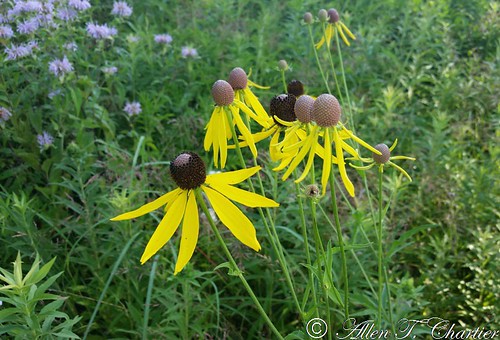
|
||
| Ratibida pinnata YELLOW CONEFLOWER Frank Mayfield |
||
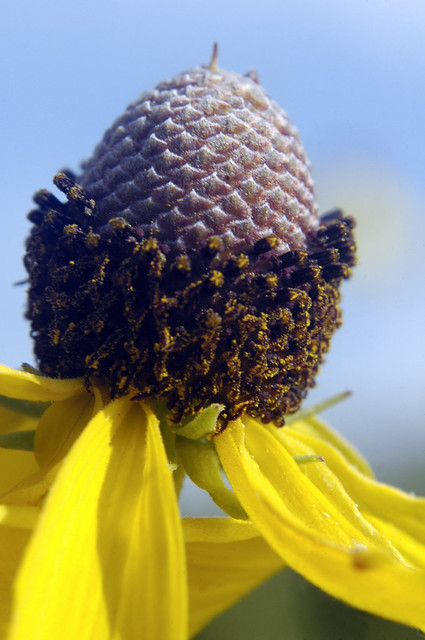
|
||

Visitor Videos |
|||
Share your video of this plant. |
|||
| This button not working for you? Simply email us at info@MinnesotaSeasons.com. Attach a video, a YouTube link, or a cloud storage link. |
|||
Other Videos |
|||
| Minnesota Native Plant - Grey-Headed Coneflower (Ratibida Pinnata) MNNativePlants |
|||
About
Published on Aug 13, 2013 Todays plant is a tall prairie plant, the Grey-Headed Coneflower (Ratibida Pinnata). |
|||
| Yellow Coneflower - Ratibida pinnata blooming at Ion Exchange Ionxchange |
|||
About
Uploaded on Aug 1, 2011 Earthyman views Yellow Coneflower (Ratibida pinnata) in full bloom at Ion Exchange in Northeast Iowa http://www.ionxchange.com |
|||
| Gray headed Coneflower manywolves11 |
|||
About
Uploaded on Aug 3, 2009 A sunny reminder of a wonderful afternoon, with a very special person, my beloved husband. |
|||

Visitor Sightings |
|||||
Report a sighting of this plant. |
|||||
| This button not working for you? Simply email us at info@MinnesotaSeasons.com. Be sure to include a location. |
|||||
|
|||||
MinnesotaSeasons.com Sightings |
|||||
Carpenter St. Croix Valley Nature Center Carver Highlands WMA, South Unit Charles A. Lindbergh State Park Clifton E. French Regional Park John Peter Hoffman Spring Brook Valley WMA Minnesota Valley NWR, Louisville Swamp Unit Minnesota Valley NWR, Rapids Lake Unit Northern Tallgrass Prairie NWR, Touch the Sky Prairie Unit Prairie Creek WMA, Koester Prairie Unit Verlyn Marth Memorial Prairie SNA |
|||||

|
Created: Last Updated: © MinnesotaSeasons.com. All rights reserved. |
